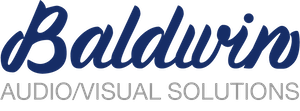Baldwin Audio/Visual Solutions was featured in Real Spaces Magazine’s industry expert interview series. Check out the most recent volume and interview here (volume 4, page 12) where our General Manager, Alex, was interviewed!
- In a few sentences, describe what your business does.
Baldwin is a one-stop-shop for your event’s audio/visual needs. We help organizations design solutions for events of all sizes, whether they are online, in-person or a hybrid of the two. Of course right now we are primarily working on virtual meetings and conferences, but we’ve spent over 30 years providing audio/visual services for in-person events as well.
- What trends have you been noticing in the industry in the last couple of years?
Even before the pandemic hit, we saw a shift towards virtual or hybrid events in our industry. The incorporation of remote presenters and online audiences was becoming more commonplace, and fully virtual events like meetings, conferences, and webcasts were starting to gain momentum.
Organizations were starting to see that they had the ability to reach larger audiences and that they could use technology to make events more accessible. Cost efficiency was also a big driver; it’s much easier to budget for an expensive keynote speaker when you are saving costs in other areas. More organizations were also looking to be more eco-conscious, and trying to minimize the amount of traveling for meetings and conferences.
- What changed or shifted as a result of COVID-19?
The move towards virtual events was greatly accelerated during the pandemic. At Baldwin, we were able to make the transition smoother for our clients by proposing many different ways that they could still connect and collaborate with the people they needed to, using custom webcasts, virtual webinars, and incorporating accessibility features into their events.
We quickly responded by setting up a virtual event studio, expanding the space we had at our current facility which allowed us to bring in accessibility providers to do simultaneous interpretation, sign language, and even closed-captioning. We’ve now built multiple dedicated studios for these services, which have been running at capacity since last summer.
- The phrase “the new normal” is now a popular part of our lexicon — what do you think “the new normal” will be for your industry going forward?
Once things start to open up again, I think organizations will continue to take advantage of virtual ways to bring people together and incorporate more of that technology into their in-person events. I think we’ll start to see venues and offices integrating virtual meeting technology into their event rooms and workspaces too.
It’s going to be very interesting to see how in-person events like conferences come back and are adapted for this virtual-first environment. For audio-visual professionals like ourselves, I think we’ll see two sides of our business develop. Our virtual event studio will now continue as a permanent part of the audio/visual services that we provide, and we will be eager to get back out and do live events once it is safe to do so.
- Since it looks like virtual events will be here to stay, do you have any tips to make them more engaging?
You’re right! I think that the focus going forward will be on creating more engaging and collaborative virtual meetings, conferences, and hybrid events. It’s hard to keep a virtual audience engaged and the length of these sessions should be adjusted to accommodate for digital fatigue. Many of our clients have done a fantastic job at recreating the fun aspects of conferences that brought people together and help break up the day. They are hosting virtual cooking classes, comedy shows, cocktail hours, and digital swag stations.
We’re also seeing platforms like Mentimeter and Slido get used a lot for more live audience participation but with added data/analytics outputs. Whether it’s poll or chat-based, organizations can produce real-time surveys and word clouds that add an additional layer of insight. Other tools like virtual whiteboards allow employees to recreate the same open-ended brainstorming and exploratory style of collaboration. Regardless of the pandemic, remote and hybrid working models will continue and organizations need to have a flexible approach and technology setups that enable this.

